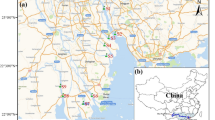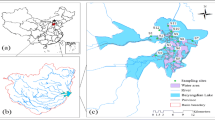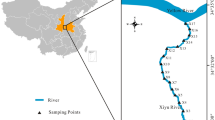Abstract
To estimate the ecological risk of toxic organic pollutant (formaldehyde) and heavy metals (mercury (Hg), arsenic (As), cadmium (Cd), and chromium (Cr)) in water and sediment from a landscape Lake in Tian** City, an ecological risk assessment was performed. The risk quotient (RQ) method and the AQUATOX model were used to assess the ecological risk of formaldehyde in landscape water. Meanwhile, the RQ method and the potential ecological risk index method were used to assess the ecological risk of four heavy metals in water and sediment from the studied landscape lake, respectively. The results revealed that the maximum concentration of formaldehyde in landscape water was lower than the environmental quality standards of surface water in China. The maximum simulated concentrations of formaldehyde in phytoplankton and invertebrates were 3.15 and 22.91 μg/L, respectively, which were far less than its toxicity data values (1000 and 510 μg/L, respectively), suggesting that formaldehyde in landscape water was at a safe level for aquatic organisms. The RQ model indicated that the risks of phytoplankton and invertebrates were higher than that of fish posed by Hg and Cd in landscape water, and the risks from As and Cr were acceptable for all test organisms. Cd is the most important pollution factor among all heavy metals in sediment from studied landscape lake, and the pollution factor sequence of heavy metals was Hg > As > Cr > Cd. The values of risk index (RI) for four heavy metals in samples a and b were 43.48 and 72.66, which were much lower than the threshold value (150), suggesting that the ecological risk posed by heavy metals in sediment was negligible.










Similar content being viewed by others
References
Aldenberg T, Slob W (1993) Confidence limits for hazardous concentrations based on logistically distributed NOEC toxicity data. Ecotoxicol Environ Saf 25:48–63
Bo L, Wang D, Li T, Li Y, Zhang G (2015) Accumulation and risk assessment of heavy metals in water, sediments, and aquatic organisms in rural rivers in the Taihu Lake region, China. Environ Sci Pollut Res 22:6721–6731
Chen Y, Niu Z, Zhang H (2013) Eutrophication assessment and management methodology of multiple pollution sources of a landscape lake in North China. Environ Sci Pollut Res 20:3877–3889
Duan W (2011) Primary study on exposure assessment and risk management of formaldehyde in aquatic products. Sci Technol Food Ind 33:304–305
Fu C, Guo J, Pan J, Qi J, Zhou W (2009) Potential ecological risk assessment of heavy metal pollution in sediments of the yangtze river within the Wanzhou section. China Biol Trace Elem Res 129:270–277
Grechi L, Franco A, Palmeri L (2016) An ecosystem model of the lower Po river for use in ecological risk assessment of xenobiotics. Ecol Model 332:42–48
Hakanson L (1980) An ecological risk index for aquatic pollution control—a sediment ecological approach. Water Res 14:975–1001
He P, Phan L, Gu G, Hervouet G (2001) Reclaimed municipal wastewater—a potential water resource in China. Water Sci Technol 43:51–58
Hernández F, Urkiaga A, Fuentes L, Bis B, Chiru E (2006) Feasibility studies for water reuse projects: an economical approach. Desalination 187-188:253–261
** X, Zha J, Xu Y, Wang Z, Kumaran S (2011) Derivation of aquatic predicted no-effect concentration (PNEC) for 2,4-dichlorophenol: comparing native species data with non-native species data. Chemosphere 84:1506–1511
Kang C, Wang Y, Du Y, Li R, Li J (2000) Improvement on the determination of volatile phenols in water. Chinese J Anal Chem 28:872–875
Kong X, Wei H, Qin N, Qi-Shuang H, Wang Y (2011) Assessing acute ecological risks of heavy metals to freshwater organisms by species sensitivity distributions. Chin Environ Sci 31:1555–1562
Kudłak B, Wolska L, Namieśnik J (2011) Determination of EC 50 toxicity data of selected heavy metals toward Heterocypris incongruens and their comparison to “direct-contact” and microbiotests. Environ Monit Assess 174:509–516
Kun L, Han X, Zhao J, Qiao F (2016) Characterization of metal kinetics and bioavailability using diffusive gradients in thin films technique in sediments of Taihu Lake, China. Ecotox Environ Safe 128:153–160
Laura G, Antonio F, Luca P (2016) An ecosystem model of the lower Po river for use in ecological risk assessment of xenobiotics. Ecol Model 332:42–58
Liang M, Chen Y (2008) A comparison of total chromium determination by potassium permanganate oxidation-diphenylcarbohydrazide spectrophotometric and flame AA. USTC of suzhou
Lin S (1992) Direct determination of trace Pb Cd Cu Mn Fe Zn in environment water by zeeman flameless atomic absorp-tion spectrometry. J GDUT
Lombardo A, Franco A, Pivato A (2015) Food web modeling of a river ecosystem for risk assessment of down-the-drain chemicals: a case study with AQUATOX. Sci Total Environ 508:214–227
Lu S, Wang Y, Teng Y, Yu X (2015) Heavy metal pollution and ecological risk assessment of the paddy soils near a zinc-lead mining area in Hunan. Environ Monit Assess 187:627
Ma Y, Wang X, Wang D (2016) Function of a landscape lake in the reduction of biotoxicity related to trace organic chemicals from reclaimed water. J Hazard Mater 318:663–670
Mengya L, Hu B, Zhou J, Wang Z, Meng W (2013) Quantitative evaluation on public water resource protection consciousness in Tian**. JAL
Miao A, Wang W, Juneau P (2005) Comparison of Cd, Cu, and Zn toxic effects on four marine phytoplankton by pulse-amplitude-modulated fluorometry. Environ Toxicol Chem 24:2603–2611
Miri M, Allahabadi A, Ghaffari HR, Fathabadi ZA, Raisi Z, Rezai M, Aval MY (2016) Ecological risk assessment of heavy metal (HM) pollution in the ambient air using a new bio-indicator. Environ Sci and Pollut R 23:14210–14220
NBS (1997) Water and wastewater monitoring and analysis method, 4th edn. China Environmental Science Press, Bei**g (in Chinese)
NBS (2002) Environmental quality standards for surface water, National Bureau of Statistics of China. Available at 03/04/2016 to: http://kjs.mep.gov.cn/hjbhbz/bzwb/shjbh/shjzlbz/200206/W020061027509896672057.pdf. (in Chinese)
NBS (2016) The population and GDP statistics of Tian**, National Bureau of Statistics of China. Available at 03/04/2016 to: http://data.stats.gov.cn/index.htm. (in Chinese)
Niu Z, Li X, Zhang Y (2017) Composition profiles, levels, distributions and ecological risk assessments of trihalomethanes in surface water from a typical estuary of Bohai Bay. Mar Pollut Bull 2017
Park R, Clough J (2004a) Modeling environmental fate and ecological effects in aquatic ecosystems volume 2: technical documentation. US EPA
Park R, Clough J (2004b) AQUATOX (Release 2): modeling environmental fate and ecological effects in aquatic ecosystems. Vol. 1: User’s manual. US environmental protection agency, Washington, DC
Park R, Clough JS, Wellman MC (2008) AQUATOX: modeling environmental fate and ecological effects in aquatic ecosystems ☆. Ecol Model 213:1–15
Pisanello F, Marziali L, Rosignoli F (2016) In situ bioavailability of DDT and Hg in sediments of the Toce River (Lake Maggiore basin, Northern Italy): accumulation in benthic invertebrates and passive samplers. Environ Sci Pollut Res 23:10542–10555
Ren H, Song B (2010) Determination of formaldehyde in water by Acetylacetone spectrophotometric method. Sci Technol Innov Herald:128–128
Robert C (2012) An ecological risk assessment of formaldehyde. Hum Ecol Risk Assess 9:483–509
Tang Y (2008) Application of hakanson index method assessing ecological risk of heavy metal from sediments in the water. Environ Sci Surv 27:66–68
Tang X, Bai Y, Duong A, Smith MT, Li L (2009) Formaldehyde in China: production, consumption, exposure levels, and health effects. Environ Int 36:1210–1224
Tisler T, Zagorc-Koncan J (1997) Comparative assessment of toxicity of phenol, formaldehyde, and industrial wastewater to aquatic organisms. Water Air Soil Poll 97:315–322
TJC (2013) The natural environment. IOP Publishing, Tjdfz. Available at 02/08/2013 to: http://www.tjdfz.org.cn/tjgl/zrhj/index.shtml
USEPA (1998) Guidelines for ecological risk assessment. EPA/630/R-95/002F
USEPA (2010) IRIS toxicological review of formaldehyde, United States environmental protection agency. Available at 08/06/2016 to: https://cfpub.epa.gov/ncea/iris_drafts/recordisplay.cfm?deid=223614
Wang X, Zang S (2015) Distribution characteristics and ecological risk assessment of toxic heavy metals and metalloid in surface water of lakes in Daqing Heilongjiang Province, China. Ecotoxicology 23:609–617
Wang N, Tang Y, Pan H, Wang P (1999) Determination of Hg, As in biological samples and chinese patent medicine by hydride generation-atomic spectrophotofluorimetry with microwave digestion. J Instrum Anal
Wang S, Sun J, Ding H (2005) Evaluation on potential ecological risk of heavy metal pollution of sediments in HAIHE river. Environ Engin 23:62–64
Wang H, Yang Z, Wang S (2011) Formaldehyde formation rule and control method in ozone disinfection of drinking water. J Public Health 27:1211–1212
Wiglusz R, Sitko E, Nikel G (2002) The effect of temperature on the emission of formaldehyde and volatile organic compounds (VOCs) from laminate flooring — case study. Build Environ 37:41–44
Wu P, Pan XD, Ma BJ, Wang LY, Zhang J (2013) Determination of phthalate esters in non-alcoholic beverages by GC–MS and optimization of the extraction conditions. Eur Food Res Technol 238:607–612
**ang Z, Chen D, Wang Q, Zhang Z (2014) Seawater desalination in China: retrospect and prospect. Chem Eng J 242:404–413
Yi L, Jiao W, Chen X, Chen W (2011) An overview of reclaimed water reuse in China. J Environ Sci 38:400–409
Zhang L, Liu J (2014) AQUATOX coupled foodweb model for ecosystem risk assessment of Polybrominated diphenyl ethers (PBDEs) in lake ecosystems. Ecol Model 265:239–249
Zhou F (2005) Freshwater micro biological map. Chemical Industry Press, China (in Chinese)
Acknowledgments
This work was supported by the National Natural Science Foundation of China (51308305) and the Program for New Century Excellent Talents in University.
Author information
Authors and Affiliations
Corresponding author
Additional information
Responsible editor: Philippe Garrigues
Rights and permissions
About this article
Cite this article
Zhang, Y., Liu, Y., Niu, Z. et al. Ecological risk assessment of toxic organic pollutant and heavy metals in water and sediment from a landscape lake in Tian** City, China. Environ Sci Pollut Res 24, 12301–12311 (2017). https://doi.org/10.1007/s11356-017-8906-8
Received:
Accepted:
Published:
Issue Date:
DOI: https://doi.org/10.1007/s11356-017-8906-8




